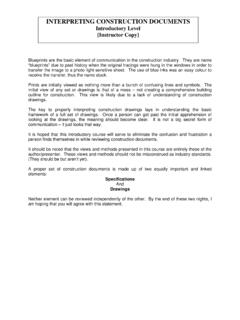Transcription of ARCHITECTURAL HISTORY OF WESTERN CIVILIZATION
1 RAIC SYLLABUS Thesis Submission Kurt Dietrich SK85ON23 ARCHITECTURAL HISTORY OF WESTERN CIVILIZATION CURRICULUM DEVELOPMENT SECTION ARCHITECTURAL Curriculum Kurt Dietrich Course Outline HISTORY SK85ON23 - 1 -INDEX: Page: I. Abstract 2 II. Preamble 2 III. Component Initiative 4 IV. Component Course Materials 4 V. Instructional Strategy 9 VI. Student Activities 10 VII. Assessment Method 10 VIII. Common Essential Learnings 11 IX. Environment 12 X. Materials and Resources Required 12 XI. Summary of ARCHITECTURAL Periods 13 XII.
2 Course Text Outline The Ancient World 16 Egyptian Architecture 20 Greek Architecture 26 Roman Architecture 36 Early Christian Architecture 45 Byzantine Architecture 51 Romanesque Architecture 56 Gothic Architecture 66 Renaissance Architecture 82 Baroque Architecture 96 The Eighteenth Century 112 The Nineteenth Century 124 The Twentieth Century 148 XIII. New Text Definitions 193 XIV. Appendix 'A': List of Illustrations 194 XV. Appendix 'B': Bibliography 201 ARCHITECTURAL Curriculum Kurt Dietrich Course Outline HISTORY SK85ON23 - 2 - ABSTRACT: The study of ARCHITECTURAL HISTORY provides an understanding of the cultural forces that shaped ARCHITECTURAL development.
3 The HISTORY of architecture chronicles the formation of the ARCHITECTURAL profession through the experience of guilds and formal education. The philosophies and design thrusts of relative periods and practitioners are reviewed as the profession changes through time. PREAMBLE: This section provides an overview of the HISTORY of architecture in WESTERN CIVILIZATION . It includes an outline of architecture covering the major periods of development. The section provides opportunities for discussion relative to the influence of society and context on ARCHITECTURAL design. Figure 1: Chateaux de Chenonceaux, France Historical study is a process of selection and interpretation. Choices were made in development of this section regarding what buildings and styles to include from the vast selection of notable ARCHITECTURAL works.
4 ARCHITECTURAL Curriculum Kurt Dietrich Course Outline HISTORY SK85ON23 - 3 - It should be noted that many of the works featured in this section took hundreds of years to construct. The physical labour for construction required generations of families to carry on the work. Construction was delayed at times as society passed through years of war and conflict, disease, changes in governments and design philosophy revisions. The actual erection of any building using only manual labour is a feat in itself. Construction of these buildings achieved this feat and surpassed it in raising structures of incredible complexity and detail. Figure 2: The Spanish Steps, Rome Vernacular building is defined as native construction, typically residential, within a specific region. The construction of lodging is the immediate cultural response to the conditions of the local lifestyle: agrarian, primitive or developed societies.
5 The language of vernacular building styles was not reviewed through this section. Housing settlements and urban development are discussed in the Geography section of this thesis submission. ARCHITECTURAL Curriculum Kurt Dietrich Course Outline HISTORY SK85ON23 - 4 - COMPONENT INITIATIVE: The goal of this section is to provide instruction on how architecture reflects the society and cultural period of development. The secondary goal illustrates how building styles and theories evolved through the centuries. This section will also review how the influence of culture and society changed the development of ARCHITECTURAL forms. COMPONENT COURSE MATERIALS: ARCHITECTURAL design involves the shaping of space so that it is functionally appropriate for its purpose, structurally adequate and expressive of beauty and artistic achievement.
6 The HISTORY of architecture is a study of expression through the use of created spaces. ARCHITECTURAL HISTORY illustrates our attempts to achieve beautiful, functional and meaningful solutions in spatial organization in order to satisfy the needs of the time and local culture. Figure 3: Uffizi Gallery, Florence ARCHITECTURAL Curriculum Kurt Dietrich Course Outline HISTORY SK85ON23 - 5 - The study of ARCHITECTURAL HISTORY relates to the study of people. It is a study of the needs, the knowledge base and the goals of each period in CIVILIZATION . Architecture reflects the conditions of the age from which it springs. Architecture is the product of all sorts of factors, social, political, economic, scientific, technical and religious beliefs. The language of architecture is permeated with a culture's sense of what they should do, where to do it, when it should be done, how important it is, and how these actions relate to the rest of the community, the material world and the supernatural world.
7 Architecture communicates to the community the meaning of their actions as well as how their actions relate to the human, material, and spiritual worlds. Figure 4: Old City Hall, Regina The definition of an ARCHITECTURAL language means that architecture can be "read". A person may discover how a culture organizes itself socially, materially and metaphysically. Architecture is like a book that a culture "writes" for its members. Architecture is also about understanding a world view. Whenever a member of a culture looks at a work of architecture in his/her realm, its meaning can be understood through the reading of the building . This meaning governs their actions and understanding of the world around them. ARCHITECTURAL Curriculum Kurt Dietrich Course Outline HISTORY SK85ON23 - 6 - The study of HISTORY plays a role in education.
8 The way we act and the things we do depend to a great extent on our past experience. Our social make-up is a combination of experience and background. One of the functions of HISTORY is to help us to live in a larger sense. HISTORY provides a wider dimension of knowledge in conjunction with our past. Early human settlements were essentially rural. Rural societies transformed into urban ones as surplus of production began to occur. The complexity of buildings and their types increased. General civil construction such as roads and bridges began. Many new building types such as schools, hospitals and recreational facilities emerged. Religious architecture retained its primacy in most societies. In Europe during the early times through medieval periods, buildings were not attributed to specific individual architects.
9 The designer was almost anonymous in these cases. Guilds were eventually formed by craftsmen to organize their trade. ARCHITECTURAL styles developed and texts on architecture began to be written. These texts became canons to be followed during the design of important works, especially religious architecture. Some examples of early HISTORY canons are the works of Vitruvius (Rome) and Vaastu Shastra (India). Figure 5: Grecian Column Detail ARCHITECTURAL Curriculum Kurt Dietrich Course Outline HISTORY SK85ON23 - 7 - The Roman writer Vitruvius created the first ARCHITECTURAL treatise for WESTERN Architecture known as the Ten Books on Architecture . He defined three essential components for a building to be deemed as Architecture: firmness, commodity and delight. Architecture was to be: Structural (Firmness): Realistically, a building is dangerous without adequate structure.
10 Practical (Commodity): A building would be regarded as nothing more than large scale sculpture without practicality. Visual Art (Delight): A building would be perceived as basic utilitarian construction without beauty. It is through possession and balance of these three items that a building would be perceived as an ARCHITECTURAL statement according to Vitruvius. Figure 6: Luxembourg Gardens, Paris ARCHITECTURAL Curriculum Kurt Dietrich Course Outline HISTORY SK85ON23 - 8 - The study of the HISTORY of architecture within WESTERN Civilizations can be broken down into seven basic general periods. Each period represents a style or combination of styles that have been developed from the previous period. An outline of the period breakdown and associated styles is: FIRST GENERAL PERIOD Ancient World Egyptian Grecian Roman SECOND GENERAL PERIOD Early Christian Architecture Byzantine THIRD GENERAL PERIOD Romanesque Gothic FOURTH GENERAL PERIOD Renaissance FIFTH GENERAL PERIOD Baroque Rococo Mannerism Georgian SIXTH GENERAL PERIOD The Eighteenth Century Neo-Classicism Romanticism Eclecticism The Nineteenth Century International Neo-Classicism Ecole Des Beaux Arts Victorian Gothic SEVENTH GENERAL PERIOD The Twentieth Century Organic Mechanical Sculptural Art Deco (Art Nouveau) An analysis of each period follows this section.





